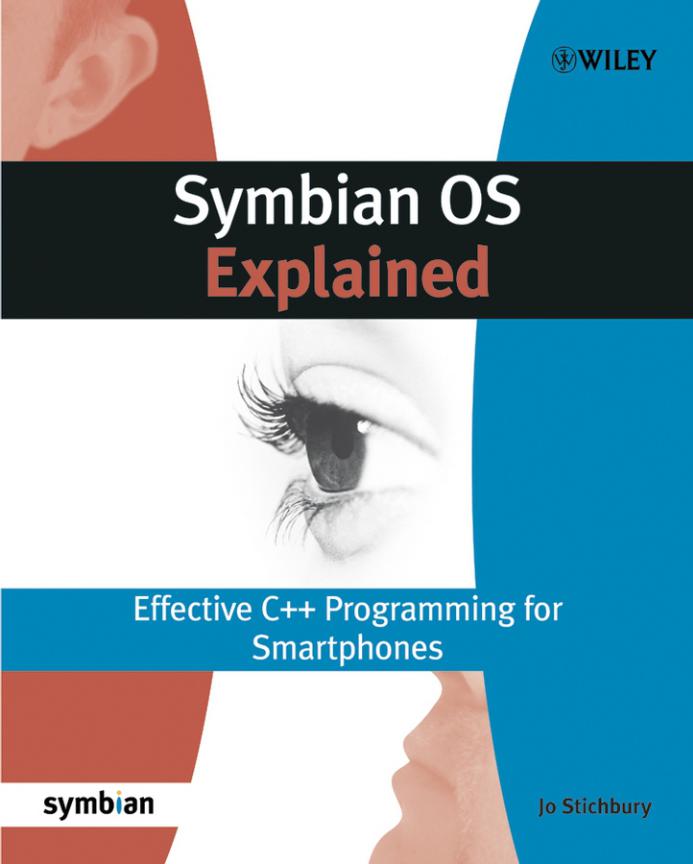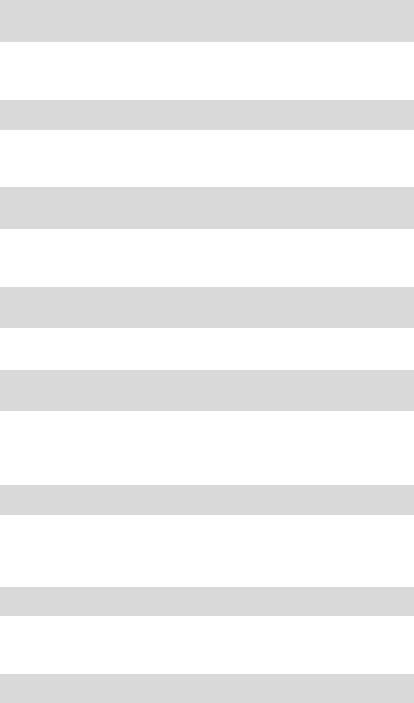
- •Contents
- •1.1 Fundamental Types
- •1.2 T Classes
- •1.3 C Classes
- •1.4 R Classes
- •1.5 M Classes
- •1.6 Static Classes
- •1.7 Buyer Beware
- •1.8 Summary
- •2 Leaves: Symbian OS Exceptions
- •2.1 Leaving Functions
- •2.3 Constructors and Destructors
- •2.4 Working with Leaving Functions
- •2.5 Trapping a Leave Using TRAP and TRAPD
- •2.6 LeaveScan
- •2.7 Summary
- •3 The Cleanup Stack
- •3.1 Using the Cleanup Stack
- •3.2 How Does the Cleanup Stack Work?
- •3.4 Using TCleanupItem for Customized Cleanup
- •3.5 Portability
- •3.6 An Incidental Note on the Use of Casts
- •3.7 Summary
- •5 Descriptors: Symbian OS Strings
- •5.3 Pointer Descriptors
- •5.4 Stack-Based Buffer Descriptors
- •5.5 Heap-Based Buffer Descriptors
- •5.6 Literal Descriptors
- •5.7 Summary
- •6 Good Descriptor Style
- •6.1 Descriptors as Parameters and Return Types
- •6.2 Common Descriptor Methods
- •6.3 The Use of HBufC Heap Descriptors
- •6.4 Externalizing and Internalizing Descriptors
- •6.5 The Overuse of TFileName
- •6.6 Useful Classes for Descriptor Manipulation
- •6.7 Summary
- •7 Dynamic Arrays and Buffers
- •7.1 CArrayX Classes
- •7.3 Why Use RArray Instead of CArrayX?
- •7.4 Dynamic Descriptor Arrays
- •7.5 Fixed-Length Arrays
- •7.6 Dynamic Buffers
- •7.7 Summary
- •8.1 Multitasking Basics
- •8.2 Event-Driven Multitasking
- •8.3 Working with Active Objects
- •8.4 Example Code
- •8.5 Threads Without an Active Scheduler
- •8.6 Application Code and Active Objects
- •8.7 Summary
- •9 Active Objects under the Hood
- •9.1 Active Object Basics
- •9.2 Responsibilities of an Active Object
- •9.3 Responsibilities of an Asynchronous Service Provider
- •9.4 Responsibilities of the Active Scheduler
- •9.5 Starting the Active Scheduler
- •9.6 Nesting the Active Scheduler
- •9.7 Extending the Active Scheduler
- •9.8 Cancellation
- •9.9 Request Completion
- •9.10 State Machines
- •9.11 Long-Running Tasks
- •9.14 Common Mistakes
- •9.15 Summary
- •10 Symbian OS Threads and Processes
- •10.2 Thread Priorities
- •10.3 Stopping a Running Thread
- •10.5 Exception Handling
- •10.6 Processes
- •10.7 Summary
- •11.2 How Do the Client and Server Fit Together?
- •11.3 How Do the Client and Server Communicate?
- •11.5 How Do Synchronous and Asynchronous Requests Differ?
- •11.6 How Is a Server Started?
- •11.7 How Many Connections Can a Client Have?
- •11.8 What Happens When a Client Disconnects?
- •11.9 What Happens If a Client Dies?
- •11.10 What Happens If a Server Dies?
- •11.15 How Many Outstanding Requests Can a Client Make to a Server?
- •11.16 Can Server Functionality Be Extended?
- •11.17 Example Code
- •11.18 Summary
- •12.2 Client Boilerplate Code
- •12.3 Starting the Server and Connecting to It from the Client
- •12.4 Server Startup Code
- •12.5 Server Classes
- •12.6 Server Shutdown
- •12.7 Accessing the Server
- •12.8 Summary
- •13 Binary Types
- •13.1 Symbian OS EXEs
- •13.2 Symbian OS DLLs
- •13.3 Writable Static Data
- •13.4 Thread-Local Storage
- •13.5 The DLL Loader
- •13.6 UIDs
- •13.8 Summary
- •14 ECOM
- •14.1 ECOM Architecture
- •14.2 Features of an ECOM Interface
- •14.3 Factory Methods
- •14.4 Implementing an ECOM Interface
- •14.5 Resource Files
- •14.6 Example Client Code
- •14.7 Summary
- •15 Panics
- •15.2 Good Panic Style
- •15.3 Symbian OS Panic Categories
- •15.4 Panicking Another Thread
- •15.5 Faults, Leaves and Panics
- •15.6 Summary
- •16 Bug Detection Using Assertions
- •16.3 Summary
- •17 Debug Macros and Test Classes
- •17.1 Heap-Checking Macros
- •17.2 Object Invariance Macros
- •17.3 Console Tests Using RTest
- •17.4 Summary
- •18 Compatibility
- •18.1 Forward and Backward Compatibility
- •18.2 Source Compatibility
- •18.3 Binary Compatibility
- •18.4 Preventing Compatibility Breaks
- •18.5 What Can I Change Without Breaking Binary Compatibility?
- •18.6 Best Practice: Planning for Future Changes
- •18.7 Compatibility and the Symbian OS Class Types
- •18.8 Summary
- •19 Thin Templates
- •20.1 Class Layout
- •20.3 Parameters and Return Values
- •20.4 Member Data and Functional Abstraction
- •20.5 Choosing Class, Method and Parameter Names
- •20.7 Summary
- •21 Good Code Style
- •21.1 Reduce the Size of Program Code
- •21.2 Use Heap Memory Carefully
- •21.3 Use Stack Memory Carefully
- •21.5 Optimize Late
- •21.6 Summary
- •Glossary
- •Bibliography and Online Resources
- •Index


Symbian OS Explained
Effective C++ Programming for Smartphones
Jo Stichbury
Reviewed by
David Batchelor, Andy Cloke, Reem EI Ghazzawi, Martin Hardman, Morgan Henry, John Pagonis, William Roberts, Keith Robertson, Phil Spencer, Colin Turfus
Managing editor
Phil Northam
Project editor
Freddie Gjertsen

Symbian OS Explained
TITLES PUBLISHED BY SYMBIAN PRESS |
|
||
• Symbian OS Explained |
|
|
|
Jo Stichbury |
|
|
|
0470 021306 |
416pp |
2004 |
Paperback |
• Symbian OS C++ for Mobile Phones, Volume 2 |
|||
Richard Harrison |
|
|
|
0470 871083 |
448pp |
2004 |
Paperback |
• Programming Java 2 Micro Edition on Symbian OS
Martin de Jode |
|
|
|
0470 092238 |
498pp |
2004 |
Paperback |
• Symbian OS C++ for Mobile Phones, Volume 1 |
|||
Richard Harrison |
|
|
|
0470 856114 |
826pp |
2003 |
Paperback |
• Programming for the Series 60 Platform and Symbian OS
Digia |
|
|
|
0470 849487 |
550pp |
2002 |
Paperback |
• Symbian OS Communications Programming |
|||
Michael J Jipping |
|
|
|
0470 844302 |
418pp |
2002 |
Paperback |
• Wireless Java for Symbian Devices |
|
||
Jonathan Allin |
|
|
|
0471 486841 |
512pp |
2001 |
Paperback |

Symbian OS Explained
Effective C++ Programming for Smartphones
Jo Stichbury
Reviewed by
David Batchelor, Andy Cloke, Reem EI Ghazzawi, Martin Hardman, Morgan Henry, John Pagonis, William Roberts, Keith Robertson, Phil Spencer, Colin Turfus
Managing editor
Phil Northam
Project editor
Freddie Gjertsen
Copyright 2005 by John Wiley & Sons, Ltd
The Atrium, Southern Gate, Chichester,
West Sussex PO19 8SQ, England
Telephone (+44) 1243 779777
Email (for orders and customer service enquiries): cs-books@wiley.co.uk
Visit our Home Page on www.wileyeurope.com or www.wiley.com
All Rights Reserved. No part of this publication may be reproduced, stored in a retrieval system or transmitted in any form or by any means, electronic, mechanical, photocopying, recording, scanning or otherwise, except under the terms of the Copyright, Designs and Patents Act 1988 or under the terms of a licence issued by the Copyright Licensing Agency Ltd, 90 Tottenham Court Road, London W1T 4LP, UK, without the permission in writing of the Publisher, with the exception of any material supplied specifically for the purpose of being entered and executed on a computer system for exclusive use by the purchaser of the publication. Requests to the Publisher should be addressed to the Permissions Department, John Wiley & Sons Ltd, The Atrium, Southern Gate, Chichester, West Sussex PO19 8SQ, England, or emailed to permreq@wiley.co.uk, or faxed to (+44) 1243 770620.
Designations used by companies to distinguish their products are often claimed as trademarks. All brand names and product names used in this book are trade names, service marks, trademarks or registered trademarks of their respective owners. The Publisher is not associated with any product or vendor mentioned in this book.
This publication is designed to provide accurate and authoritative information in regard to the subject matter covered. It is sold on the understanding that the Publisher is not engaged in rendering professional services. If professional advice or other expert assistance is required, the services of a competent professional should be sought.
Other Wiley Editorial Offices
John Wiley & Sons Inc., 111 River Street, Hoboken, NJ 07030, USA
Jossey-Bass, 989 Market Street, San Francisco, CA 94103-1741, USA
Wiley-VCH Verlag GmbH, Boschstr. 12, D-69469 Weinheim, Germany
John Wiley & Sons Australia Ltd, 33 Park Road, Milton, Queensland 4064, Australia
John Wiley & Sons (Asia) Pte Ltd, 2 Clementi Loop #02-01, Jin Xing Distripark, Singapore 129809
John Wiley & Sons Canada Ltd, 22 Worcester Road, Etobicoke, Ontario,
Canada M9W 1L1
Wiley also publishes its books in a variety of electronic formats. Some content that appears in print may not be available in electronic books.
Library of Congress Cataloging-in-Publication Data
Stichbury, Jo.
Symbian OS explained effective C++ programming for smartphones / By Jo Stichbury. p. cm.
Includes bibliographical references and index. ISBN 0-470-02130-6 (pbk. alk. paper)
1. Mobile communication systems–Computer programs. 2. Operating systems (Computers) 3. C++ (Computer program language) I. Title.
TK6570.M6S745 2004 |
|
005.265–dc22 |
2004015414 |
British Library Cataloguing in Publication Data
A catalogue record for this book is available from the British Library
ISBN 0-470-02130-6
Typeset in 10/12pt Optima by Laserwords Private Limited, Chennai, India Printed and bound in Great Britain by Biddles Ltd, King’s Lynn
This book is printed on acid-free paper responsibly manufactured from sustainable forestry in which at least two trees are planted for each one used for paper production.
Contents
Foreword |
xi |
|
About This Book |
xiii |
|
Who Is It For? |
xiv |
|
How to Use This Book |
xiv |
|
Notation and Code Conventions Used in This Book |
xv |
|
Introduction to Symbian OS |
xvii |
|
Author Biography |
xxi |
|
Author’s Acknowledgments |
xxiii |
|
Symbian Press Acknowledgments |
xxv |
|
1 Class Name Conventions on Symbian OS |
1 |
|
1.1 |
Fundamental Types |
1 |
1.2 |
T Classes |
3 |
1.3 |
C Classes |
4 |
1.4 |
R Classes |
6 |
1.5 |
M Classes |
7 |
1.6 |
Static Classes |
11 |
1.7 |
Buyer Beware |
11 |
1.8 |
Summary |
12 |
2 Leaves: Symbian OS Exceptions |
13 |
|
2.1 |
Leaving Functions |
13 |
2.2 |
Heap Allocation Using new (ELeave) |
16 |
2.3 |
Constructors and Destructors |
17 |
vi |
|
CONTENTS |
|
|
2.4 |
Working with Leaving Functions |
18 |
|
2.5 |
Trapping a Leave Using TRAP and TRAPD |
20 |
|
2.6 |
LeaveScan |
26 |
|
2.7 |
Summary |
27 |
3 |
The Cleanup Stack |
29 |
|
|
3.1 |
Using the Cleanup Stack |
31 |
|
3.2 |
How Does the Cleanup Stack Work? |
35 |
|
3.3 |
Using the Cleanup Stack with Non-CBase Classes |
38 |
|
3.4 |
Using TCleanupItem for Customized Cleanup |
44 |
|
3.5 |
Portability |
46 |
|
3.6 |
An Incidental Note on the Use of Casts |
46 |
|
3.7 |
Summary |
47 |
4 |
Two-Phase Construction |
49 |
|
5 Descriptors: Symbian OS Strings |
55 |
||
|
5.1 |
Non-Modifiable Descriptors |
56 |
|
5.2 |
Modifiable Descriptors |
58 |
|
5.3 |
Pointer Descriptors |
60 |
|
5.4 |
Stack-Based Buffer Descriptors |
63 |
|
5.5 |
Heap-Based Buffer Descriptors |
65 |
|
5.6 |
Literal Descriptors |
69 |
|
5.7 |
Summary |
72 |
6 |
Good Descriptor Style |
75 |
|
|
6.1 |
Descriptors as Parameters and Return Types |
75 |
|
6.2 |
Common Descriptor Methods |
78 |
|
6.3 |
The Use of HBufC Heap Descriptors |
82 |
|
6.4 |
Externalizing and Internalizing Descriptors |
84 |
|
6.5 |
The Overuse of TFileName |
86 |
|
6.6 |
Useful Classes for Descriptor Manipulation |
87 |
|
6.7 |
Summary |
88 |
7 Dynamic Arrays and Buffers |
91 |
||
|
7.1 |
CArrayX Classes |
92 |
|
7.2 |
RArray<class T> and RPointerArray<class T> |
97 |
|
7.3 |
Why Use RArray Instead of CArrayX? |
102 |
|
7.4 |
Dynamic Descriptor Arrays |
103 |
|
7.5 |
Fixed-Length Arrays |
104 |
|
7.6 |
Dynamic Buffers |
106 |
|
7.7 |
Summary |
109 |
8 Event-Driven Multitasking Using Active Objects |
111 |
||
8.1 Multitasking Basics |
111 |
|
CONTENTS |
vii |
8.2 |
Event-Driven Multitasking |
112 |
8.3 |
Working with Active Objects |
115 |
8.4 |
Example Code |
120 |
8.5 |
Threads Without an Active Scheduler |
123 |
8.6 |
Application Code and Active Objects |
123 |
8.7 |
Summary |
124 |
9 Active Objects under the Hood |
127 |
|
9.1 |
Active Object Basics |
128 |
9.2 |
Responsibilities of an Active Object |
131 |
9.3 |
Responsibilities of an Asynchronous Service Provider |
133 |
9.4 |
Responsibilities of the Active Scheduler |
134 |
9.5 |
Starting the Active Scheduler |
135 |
9.6 |
Nesting the Active Scheduler |
135 |
9.7 |
Extending the Active Scheduler |
136 |
9.8 |
Cancellation |
137 |
9.9 |
Request Completion |
138 |
9.10 |
State Machines |
138 |
9.11 |
Long-Running Tasks |
143 |
9.12 |
Class CIdle |
146 |
9.13 |
Class CPeriodic |
148 |
9.14 |
Common Mistakes |
149 |
9.15 |
Summary |
150 |
10 Symbian OS Threads and Processes |
151 |
|
10.1 |
Class RThread |
152 |
10.2 |
Thread Priorities |
155 |
10.3 |
Stopping a Running Thread |
157 |
10.4 |
Inter-Thread Data Transfer |
162 |
10.5 |
Exception Handling |
163 |
10.6 |
Processes |
164 |
10.7 |
Summary |
166 |
11 The Client–Server Framework in Theory |
167 |
|
11.1 |
Why Have a Client–Server Framework? |
168 |
11.2 |
How Do the Client and Server Fit Together? |
168 |
11.3 |
How Do the Client and Server Communicate? |
170 |
11.4What Classes Does the Client–Server Framework Use? 170
11.5How Do Synchronous and Asynchronous Requests
|
Differ? |
179 |
11.6 |
How Is a Server Started? |
179 |
11.7 |
How Many Connections Can a Client Have? |
180 |
11.8 |
What Happens When a Client Disconnects? |
180 |
11.9 |
What Happens If a Client Dies? |
181 |
11.10 |
What Happens If a Server Dies? |
181 |
viii |
CONTENTS |
11.11How Does Client–Server Communication Use Threads? 181
11.12What Are the Implications of Server-Side Active
|
Objects? |
182 |
11.13 |
What Are the Advantages of a Local (Same-Process) |
|
|
Server? |
182 |
11.14 |
What Are the Overheads of Client–Server |
|
|
Communication? |
183 |
11.15 |
How Many Outstanding Requests Can a Client Make to |
|
|
a Server? |
186 |
11.16 |
Can Server Functionality Be Extended? |
186 |
11.17 |
Example Code |
186 |
11.18 |
Summary |
187 |
12 The Client–Server Framework in Practice |
189 |
|
12.1 |
Client–Server Request Codes |
190 |
12.2 |
Client Boilerplate Code |
191 |
12.3 |
Starting the Server and Connecting to It from the Client |
198 |
12.4 |
Server Startup Code |
203 |
12.5 |
Server Classes |
205 |
12.6 |
Server Shutdown |
213 |
12.7 |
Accessing the Server |
214 |
12.8 |
Summary |
214 |
13 Binary Types |
217 |
|
13.1 |
Symbian OS EXEs |
217 |
13.2 |
Symbian OS DLLs |
218 |
13.3 |
Writable Static Data |
220 |
13.4 |
Thread-Local Storage |
223 |
13.5 |
The DLL Loader |
226 |
13.6 |
UIDs |
226 |
13.7 |
The targettype Specifier |
228 |
13.8 |
Summary |
230 |
14 ECOM |
233 |
|
14.1 |
ECOM Architecture |
233 |
14.2 |
Features of an ECOM Interface |
236 |
14.3 |
Factory Methods |
237 |
14.4 |
Implementing an ECOM Interface |
240 |
14.5 |
Resource Files |
242 |
14.6 |
Example Client Code |
245 |
14.7 |
Summary |
246 |
15 Panics |
247 |
|
15.1 |
Just-In-Time Debugging |
248 |
15.2 |
Good Panic Style |
249 |
|
CONTENTS |
ix |
15.3 |
Symbian OS Panic Categories |
250 |
15.4 |
Panicking Another Thread |
251 |
15.5 |
Faults, Leaves and Panics |
253 |
15.6 |
Summary |
253 |
16 Bug Detection Using Assertions |
255 |
|
16.1 |
__ASSERT_DEBUG |
256 |
16.2 |
__ASSERT_ALWAYS |
261 |
16.3 |
Summary |
263 |
17 Debug Macros and Test Classes |
265 |
|
17.1 |
Heap-Checking Macros |
265 |
17.2 |
Object Invariance Macros |
270 |
17.3 |
Console Tests Using RTest |
273 |
17.4 |
Summary |
276 |
18 Compatibility |
277 |
|
18.1 |
Forward and Backward Compatibility |
278 |
18.2 |
Source Compatibility |
279 |
18.3 |
Binary Compatibility |
280 |
18.4 |
Preventing Compatibility Breaks |
281 |
18.5What Can I Change Without Breaking Binary
|
Compatibility? |
287 |
18.6 |
Best Practice: Planning for Future Changes |
289 |
18.7 |
Compatibility and the Symbian OS Class Types |
291 |
18.8 |
Summary |
292 |
19 Thin Templates |
293 |
|
20 Expose a Comprehensive and |
|
|
Comprehensible API |
299 |
|
20.1 |
Class Layout |
300 |
20.2 |
IMPORT_C and EXPORT_C |
301 |
20.3 |
Parameters and Return Values |
303 |
20.4 |
Member Data and Functional Abstraction |
309 |
20.5 |
Choosing Class, Method and Parameter Names |
312 |
20.6 |
Compiler-Generated Functions |
314 |
20.7 |
Summary |
315 |
21 Good Code Style |
317 |
|
21.1 |
Reduce the Size of Program Code |
317 |
21.2 |
Use Heap Memory Carefully |
320 |
21.3 |
Use Stack Memory Carefully |
325 |
21.4Eliminate Sub-Expressions to Maximize Code
Efficiency |
328 |
x |
CONTENTS |
|
21.5 |
Optimize Late |
330 |
21.6 |
Summary |
331 |
Appendix Code Checklist |
333 |
|
Glossary |
|
339 |
Bibliography and Online Resources |
347 |
|
Index |
|
351 |

Foreword
Charles Davies, Chief Technical Officer, Symbian
Software engineers live in interesting times: software is becoming pervasive. We all increasingly rely on our personal computers and use their software as an essential tool in organizing our lives. But what we ”see” is just the tip of the iceberg. Most software exists beneath the surface within a variety of embedded systems such as electronic consumer devices, motor cars, and aircraft. Symbian OS is targeted at mobile phones – a class of embedded system that exists in massive volume and which is used by the entire developed world.
The amount of software built into a mobile phone is expanding rapidly. In recent times it has outpaced Moore’s law: in the past three years the amount of embedded software in high-end phones has jumped from
xii FOREWORD
about 2 MB to 20 MB. This is partly required by the sophistication of new 3G networks, but it is mainly due to mobile phones subsuming the functionality of other portable consumer devices, such as digital cameras and camcorders, digital audio players, video players, electronic organizers, mobile gaming consoles, portable radios, portable TVs, email terminals, cordless phones and even electronic payment cards. The mobile phone is becoming the key portable lifestyle support system – an electronic Swiss army knife.
Symbian OS is needed because this explosion in software-supported functionality requires a capable operating system that is designed for sophisticated, always-on, battery-powered mobile devices.
The object-oriented programming paradigm of Symbian OS helps manage system complexity and permeates the architecture of Symbian OS. This architecture uses many advanced, but classical, constructs found in other multitasking operating systems. Examples include preemptive multitasking threads, processes, asynchronous services and internal servers for serializing access to shared resources. Symbian OS has some particular features that also need to be understood if one is to become an effective Symbian OS programmer. These distinct features have been designed to cope with the rigorous discipline of mobile device programming, for example, in the handling of asynchronous events and errors, avoiding memory leakages and other dangling resources.
Software engineers moving from the embedded space will probably have to make a transition from C to the object-oriented world of C++. Software engineers moving from the PC space will probably be used to C++, but will not be used to the tougher disciplines of programming for mobile phones where robustness, code size, memory usage, performance and battery life is important, where there are no regular reboots to mop up memory leaks and where the radio increases and enriches the number of events to which applications have to respond.
Whatever your background and level of experience, your effectiveness will be much improved if you read this book and understand the essential Symbian OS concepts.

About this Book
Developing good C++ code on Symbian OS requires a clear understanding of the underlying concepts and the nature of the operating system. This book explains the key features of Symbian OS and shows how you can use this knowledge most effectively. It also focuses on some aspects of good C++ style that particularly apply to Symbian OS. With understanding and practice, the expertise required to write high quality C++ code on Symbian OS should become second nature.
The book is divided into a series of self-contained chapters, each discussing specific and important features of Symbian OS. Besides the fundamentals, the chapters illustrate best practice and describe any common mistakes to avoid. The chapters are concise enough to impart the insight you need without being so brief as to leave you needing more information. Each chapter delivers simple and straightforward explanations without omitting the important facts.
This book doesn’t teach you how to write C++. It assumes you’re already familiar with the most important concepts of the language. Neither does it walk through Symbian OS from the perspective of developing a particular application. Instead, I try to impart an understanding of the central concepts and key features of Symbian OS and good techniques in C++. To quote from Scott Meyers,1 whose book inspired me to write this one, ”In this book you’ll find advice on what you should do, and why, and what you should not do, and why not”.
1 Scott Meyers, Effective C++: 50 specific ways to improve your programs and designs, 1997. See the Bibliography for further details.
xiv |
ABOUT THIS BOOK |
Who Is It For?
The book assumes a reasonable understanding of programming in C++. It does not assume in-depth knowledge of Symbian OS and covers the basics such as descriptors (Chapters 5 and 6) and active objects (Chapters 8 and 9) as well as more complex features such as the Symbian OS client–server architecture (Chapters 11 and 12) and ECOM (Chapter 14).
The book focuses upon the core of the operating system, which should be equally applicable to all versions of Symbian OS, and user interfaces, such as UIQ and Series 60. If there are any important differences between platforms, they are highlighted. At the time of writing (Spring 2004), Symbian is preparing to release a new version of the operating system, Symbian OS v8.0. This book explicitly indicates any changes that the new version will introduce, where the author is aware of them.
If you are a developer targeting, or thinking of targeting, Symbian OS, this book will show you how to write the most effective C++. You will benefit from a greater understanding of the characteristic features and design of the operating system, and confidence in how to use them. However experienced you are with Symbian OS, there are always new tricks to learn, which is why this book will appeal to all levels of developer. It reflects the combined wisdom of the many experienced Symbian OS developers I have worked with. Over the years, they have taught me a great deal, and when I looked more closely at parts of the OS whilst writing this book, I learnt even more. I hope you will too.
How to Use This Book
As I’ve already mentioned, the book is split into a number of chapters, where each chapter acts as a guide to a particular feature of Symbian OS. The title of each, a detailed table of contents and the index, glossary and bibliography sections are all designed to help you find the information you need.
The chapters do not necessarily need to be read in sequence. Rather, the book can be dipped into for revision, reference or to provide a handy ”tip for the day”; it does not necessarily need to be read from cover to cover. The chapters cross-reference each other where there is overlap between them, to indicate which other areas are particularly relevant to the discussion.
For clarification and explanation, the chapters also use example code which has been designed to illustrate good coding style and the conventions of Symbian OS code and code layout.

ABOUT THIS BOOK |
xv |
Notation and Code Conventions Used in This Book
The textual layout of this book is self-explanatory, but the code layout needs some introduction. Where I use example code, it will be highlighted as follows:
This is example code;
C++ code for Symbian OS uses an established naming convention which you should try to stick to in order for your own code to communicate its intent most clearly. Besides communication, the main benefit of adhering to the convention is that it is chosen to reflect clearly object cleanup and ownership.
The best way to get used to it is to look at code examples such as those found in your chosen SDK as well as in this book. The main features of the naming conventions are described here; in Chapter 1, I discuss the class name prefix conventions, while Chapter 2 covers the reason for the trailing L on some function names and Chapter 3 discusses the use of trailing C.
Capitalization
The first letter of class names should be capitalized:
class TClanger;
The words making up variable, class or function names should be adjoining, with the first letter of each word capitalized where appropriate (parameters, automatic, global and member variables, and function parameters have a lower case first letter). The rest of each word should be lower case, including acronyms:
void SortFunction();
TInt myLocalVariable;
CMemberVariable* iDevilsHaircut;
class CActiveScheduler;
class CBbc;//Acronyms are not usually written in upper case
Global variables tend to be discouraged, but typically start either with an initial capital letter or are prefixed with a lower case ”g”.
Prefixes
Member variables are prefixed with a lower case ”i” which stands for ”instance”.

xvi |
ABOUT THIS BOOK |
TInt iCount;
CPhilosopher* iThinker;
Parameters are prefixed with a lower case ”a” which stands for ”argument”. Do not use ”an” for arguments that start with a vowel.
void ExampleFunction(TBool aExampleBool, const TDesC& aName);
Note TBool aExampleBool rather than TBool anExampleBool. Automatic variables have no prefix and the first letter is lower case.
TInt index;
CMyClass* ptr = NULL;
Class names should be prefixed with an appropriate letter (”C”, ”R”, ”T” or ”M” as described fully in Chapter 1).
class CActive;
class TParse;
Constants should be prefixed with ”K”.
const TInt KMaxFilenameLength = 256;
#define KMaxFilenameLength 256
Enumeration members are prefixed with ”E”. Enumerations are types, and so are prefixed with ”T” (you can find more information about T classes in Chapter 1).
enum TChilliPeppers {EScotchBonnet, EJalapeno, ECayenne};
Suffixes
A trailing ”L” on a function name indicates that the function may leave.
void ConstructL();
A trailing ”C” on a function name indicates that the function returns a pointer that has been pushed onto the cleanup stack.
CPhilosopher* NewLC();

ABOUT THIS BOOK |
xvii |
A trailing ”D” on a function name means that it will result in the deletion of the object referred to by the function.
TInt ExecuteLD(TInt aResourceId);
Underscores
Underscores should be avoided except in macros (__ASSERT_DEBUG) or resource files (MENU_ITEM).
Code layout
You’ll notice that the curly bracket layout in Symbian OS code, used throughout this book, is to indent the bracket as well as the following statement. I’m not a big fan of this, and I don’t think it makes that much difference if you use an alternative layout. However, if you want to stick to writing code the ”Symbian way”, you should adhere to the following convention:
void EatChilliL(CChilliPepper* aChilli)
{
if (!aChilli)
{
User::Leave(KErrArgument);
}
TChilliType type = aChilli->Type(); if (EScotchBonnet==type)
{
User::Leave(KErrNotSupported);
}
DoEatChilliL(aChilli);
}
Tips
Throughout the book, tips and advice are signified by a symbol in the margin.
These tips complement each section, providing reminders of key elements of the discussion.
Introduction to Symbian OS
A key characteristic of a mobile phone is that it is small – as small and as light as possible.
xviii |
ABOUT THIS BOOK |
It’s with you all the time, ready to send and receive phone calls or messages, play alarms to wake you, connect to the phone network or other devices, organize your personal information or play games. Whatever you want to do, you want access to your phone to be instant. It should be ready without the long boot-up you expect from a PC. It should react to user input from the moment you pick it up. And it should be reliable. As a mobile phone owner, how many of your contacts’ phone numbers do you know? Your phone keeps your personal data for you and it’s essential that it doesn’t lose it.
Let’s examine the consequences of these features on the design of a mobile operating system, such as Symbian OS. The phone may be small and light, but, as users, we still demand it to have a reasonable battery life. This places huge importance on efficient power management. The operating system cannot drain the battery and must allow the processor to power parts of the system down where possible, although it cannot ever power off completely because it must handle incoming calls and messages, and signal alarms.
The user expects the phone to be responsive, not sluggish to respond to each key press; the operating system and hardware must carefully balance demands for good performance speed with the consumption requirements of power-hungry processors. Costs are also important: they limit the processor and amount of memory in a mobile device. The operating system must be efficient, to make best use of the limited processor and memory resources available, whilst using the least power.
Besides being efficient, the operating system must be robust when the limited resources are exhausted. It must be engineered to cope with low memory conditions, loss of power or when a communications link is unavailable. Memory management is key. The operating system must track precious system resources accurately and free them when they are not required. It’s not acceptable for memory to slowly leak away, resulting in disintegration in performance and usability until the user is forced to reboot. The operating system should make it easy for software engineers to write code that runs without memory leaks and can handle out-of-memory conditions when they occur.
The mobile phone market is a mass market, with many millions of units shipped. It’s difficult, if not impossible, to recall them or require the user to upgrade through service packs. So when a phone is shipped, it’s shipped. It must not have any serious defects. Not only must the platform on which a phone is based be well-engineered, it must also provide the means for developers to build, debug and test robust code.
As users, we also demand that our mobile phones are as cheap as possible. We want the latest, trendiest phone, which may just be smaller than the last, or have additional features like Bluetooth, an integrated camera or video player, or an MP3 player. This means that the lifetime of a phone in the marketplace is limited. When a manufacturer develops a
ABOUT THIS BOOK |
xix |
phone it must be ready for market as quickly as possible and the operating system should ideally be flexible so the basic design can be extended or upgraded and released in a different model.
Symbian OS was designed for mobile devices, from its earliest incarnation as EPOC32 in the Psion Series 5. Many of the requirements of today’s mobile phones applied equally well in those days, and its design reflects that. The huge demands upon a mobile operating system have shaped Symbian OS, from resilient power-management and careful use of memory resources, to the sophisticated use of C++ and object-oriented programming techniques. As a developer on Symbian OS, you benefit from a platform which was created specifically for mobile devices and which has evolved with the market.
Of course, the responsibilities don’t stop with the operating system. To work most successfully on a mobile phone, your code must also be efficient, robust, responsive and extensible. Some of the problems of mobile computing are notoriously difficult to solve and programming in C++ is complex at the best of times. It’s not easy, but opting to work on Symbian OS gives you the benefits of a purpose-built platform. This book brings you the best advice from those experienced in working with it.
Author Biography
Jo Stichbury
Jo Stichbury was educated at Magdalene College, Cambridge, where she held the Stothert Bye-Fellowship. She has an MA in Natural Sciences (Chemistry) and a PhD in the chemistry of organometallic Molybdenum complexes. After a brief spell in postdoctoral research at Imperial College, she joined Psion Software in 1997, when Symbian OS was still known fondly as EPOC32. She has worked with the operating system ever since, within the Base, Connectivity and Security teams of Symbian, and also for Advansys, Sony Ericsson and Nokia.
As the contents of this book will reveal, Jo has a somewhat unhealthy interest in the Clangers and Greek mythology. She currently lives in Vancouver with her partner and two cats.
Author’s Acknowledgments
Once upon a time, when I joined Psion Software, there weren’t any books available on Symbian OS (which was known then as EPOC32). So I’d like to acknowledge, with gratitude, the support I received from Morgan Henry, Matthew Lewis, Peter Scobie and Graham Darnell, who helped me take my first steps as a programmer. I intend this book to record their insight and knowledge as I’ve interpreted it, as well as that of all the other Symbian OS developers I’ve worked with since.
I am grateful to everyone who has contributed to this book. Leon Clarke, Will Bamberg, Mark Jacobs and Paul Stevens made useful suggestions at the early stages; later on, Julian Lee, Keith Robertson and Dennis May answered my technical questions. Will Bamberg provided me with his own well-crafted documents on leaves and out-of-memory testing – and didn’t complain when I de-articulated them for inclusion in Chapters 2 and 17.
The input from all my reviewers was much appreciated. I would like to thank the official reviewers: Keith, David, John, Colin, Andrew, Morgan, Martin, Phil and Reem who all contributed enormously to the technical accuracy of this book and to my peace of mind. I also received many helpful contributions from Peter van Sebille and John Blaiklock at Sony Ericsson, Mark Jacobs and William Roberts at Symbian and Will Bamberg.
I’m very grateful to Dave Morten, Steve Burke and Brigid Mullally at Sony Ericsson, for showing understanding about the time it took me to write this book. I couldn’t have done it without their cooperation. The diagrams in this book were inspired by Brigid.
This book would also have been impossible without the help and support of my partner Mark, who makes everything possible. Since I started writing, I’ve also acquired two Siamese cats, who have spent more time distracting me than helping but, for that alone, they deserve inclusion here.
xxiv |
AUTHOR’S ACKNOWLEDGMENTS |
I would like to thank Symbian Press, particularly Freddie Gjertsen and Phil Northam, for their patience and fortitude. Thanks must also go to Gaynor Redvers-Mutton at John Wiley and to Karen Mosman who started the ball rolling.
I’d also like to thank Oliver Postgate for granting me permission to include the Clangers.
Symbian Press Acknowledgments
First and foremost we would like to thank Jo for her tireless endeavour in the production of this book.
Thanks are also due to all our reviewers, named and otherwise, and especially to young Phil, choleric beyond his years. Where would we be without ”constructive” criticism?
And last, but not least, thanks to the lovely Boundary Row tea-ladies, Gayle and Victoria. Without constant refreshment to sustain us, Symbian Press would be nought.
Cover design based upon a concept by Jonathan Tastard.
Code checklist based on the documentation of System Management Group, Symbian.
